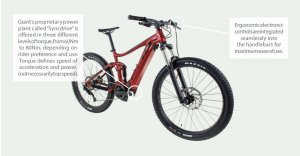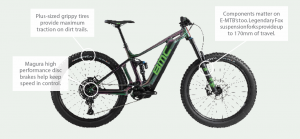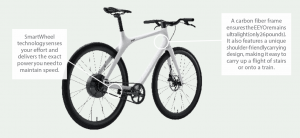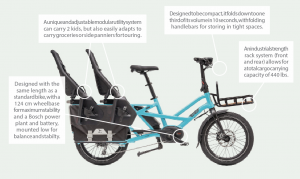Barbara Kline never says no to a dinner date on a bicycle anymore. Not since she and her partner Harry Huffaker got e-bikes.
“They put a smile on my face every time I feel that little surge of power as I’m pedaling up a hill in Elkhorn,” said Kline. “On any given summer evening when the sun stays up late, we’ll jump on our e-bikes and ride from our home in Greenhorn to Ketchum or Hailey for a nice summer dinner outdoors. It’s so much more fun than jumping in the car to go out.”
E-bikes, which have electric motors that assist pedal power, were a bit of a tough sell when they made their debut in Sun Valley 15 years ago. They’re all the rage now, thanks to bikes that weigh under 40 pounds and sport more efficient motors and a longer range that allows pedal pushers to go more than 50 miles in the economy gear.
“I’ve been selling e-bikes for 15 years. And, if we sold 10 bikes a year the first few years, that was a lot,” said Olin Glenne, CEO of Sturtevants. “Two seasons ago they really started ramping up and now they’re one of the essential pieces of our business.”
Paddy McIlvoy, managing partner of Backwoods Mountain Sports, admits to being an e-bike snob when the bicycles debuted. He changed his opinion as he began seeing the difference they made in people’s lives.
“I love seeing couples who are now able to ride together because one rides an e-bike while the other rides a regular bike,” he said. “E-bikes are a leveler, a democratizer of access. And the Wood River Valley has an amazing number of trails open to e-bikes compared with other places. If you take nothing but Greenhorn, that’s large enough. But we have the trails that are open to motor bikes out Croy, trails past Warm Springs and, hopefully soon, the hundred-plus miles that the Bureau of Land Management is building in the south valley.”
E-bikes range in price from $1,199 to $7,900. There are nearly as many varieties of e-bikes as regular bikes. There are e-bikes designed for the road, and others designed for mountains, snow or sand. There are cargo bikes, foldable e-bikes, bikes with front-suspensions, choppers and cruisers. One Sun Valley resident even has a three-wheeler e-bike.
“There are a lot of e-bikers in Elkhorn and there are people commuting to Ketchum from Hailey,” said Glenne. “Some riders carry their kids on back; others, their groceries. For a good six months of the year they can replace cars.”
The bikes have rechargeable batteries that can be plugged into a regular household outlet. They can go as fast as 20 miles an hour, although riders generally stay under that. Most bikes have four different levels of assist ranging from economy to turbo. Riders can pick the degree of difficulty they want based on how much exercise they want to get. Some pedal without assist on downhills and flats, then happily move into gear while biking uphill from Hailey into a headwind.
“They do for biking what shape skis did for skiing,” said Huffaker. “They allow older adults to ride with their grandchildren and get out there and exercise. I can still ride over Elkhorn with a road bike, but an e-bike makes it a lot more fun, and it’s easier to work up the motivation.”
Andrea Lieberman was sweating her way to work as she pedaled up the steep hills of Seattle when her neighbor loaned her his e-bike.
“It was like I saw the light—like God had spoken to me,” she said of the experience. “I was easily passing all these cars stuck in traffic. And it no longer took an hour to go 3.5 miles.”
When she and her husband Jamie moved to Elkhorn, they quickly included e-bikes in their stable of mountain bikes and road bikes for trips to the post office, grocery store and concerts.
“They’re just so much fun,” said Lieberman. “They allow us to leave our car in the garage, quit burning fossil fuels and get outdoors more.”
E-bike tires are generally wider than road bikes so they handle dirt roads like those in Muldoon Canyon nicely. Some mountain bikers have happily used them to get out farther on canyon roads. But cyclists have to be careful—the heavier bikes can be tough to pedal uphill should the power run out.
“The upside is they can get you out there,” McIlvoy said. “The downside is that they will get you way out there.”
WHICH E-BIKE IS BEST FOR ME?
By Adrian Montgomery / CrankTank
Now that you’re interested in an e-bike, it’s time to narrow down the options a bit. E-bikes are generally classified based on function and power. Here is a quick rundown of all the bikes in the “Pedelec” or power-assist category. This means the bike applies power only while you pedal; it does not have a throttle. Hear are the three different classifications of e-bikes:
Class 1 – Pedelec e-bikes create 300 watts of power assist and are capable of going 20mph.
Class 2 – E-bikes create 500 watts of power assist with a max speed of 20mph.
Class 3 – E-bikes generate 350 watts but are capable of 28mph speeds.
Always check the regulations in the area you intend to ride before getting started. As an example, the Wood River Trail is designated non-motorized but has not yet embraced any classification regulations on it. Be a good steward of the trail no matter what, but certainly going 28mph down the bike path should be cause to question your venue choices.
CAN IT REPLACE MY CAR?
Some locals have done just that—using cargo / utility e-bikes in place of their car (yes, even in chilly winter months). And even if you aren’t quite ready to take that plunge and commit to one hundred percent pedal power all the time, a commuter e-bike in the cargo / utility category can replace trips to the hardware store or grocery store most months of the year.
Just like any bike, e-bikes also come with a wide array of components and technical specs that may make a difference to your comfort and ease when using them—and your wallet. Higher end e-bikes tend to use mid-drive motors (where the motor is mounted in the center of the bike, transferring power to the wheel via the chain), while more affordable options often use hub-drive motors (where the motor is in the hub of the bike’s wheel). The difference might not be evident on the first test drive, but mid-drive motors help balance the bike’s weight better and allow for easier gear shifting—a bonus if traveling long distances or with larger cargo. Also look for dual battery systems to increase range. Here are a few two-wheeled options that might replace your four-wheeled car.
The E-MTB
An E-MTB is a mountain bike with power assist, designed for use on trails. Built similar to a traditional mountain bike, an E-MTB uses bicycle components and tires that resemble its analog brother, but it is equipped with a motor to assist the rider in overcoming even the most difficult terrain. Bikes in this category can weigh between 38-60 pounds, they have adequate range to tantalize every single-track fantasy, and are quiet, with a distinct bicycle feel.
Giant Stance E+ 2 Power
 Giant is an award-winning Mountain Bike maker with a history of reliability and affordability. The Stance E+ borrows it’s patented suspension design from it’s acoustic lookalikes and adds the performance of Giant’s “Syncdrive” system. This bike has a range of up to 40 miles and delivers seamless power assist at up to 19mph.
Giant is an award-winning Mountain Bike maker with a history of reliability and affordability. The Stance E+ borrows it’s patented suspension design from it’s acoustic lookalikes and adds the performance of Giant’s “Syncdrive” system. This bike has a range of up to 40 miles and delivers seamless power assist at up to 19mph.
BMC Trailfox AMP SX Two
 This bike is meant to enjoy trails, and it does a fantastic job of it. It’s trail tuned Fox suspension keeps the bike planted and in control, while the Shimano power plant delivers unrivaled power delivery and reliability. Great for riders who want a playful, responsive and thrilling ride.
This bike is meant to enjoy trails, and it does a fantastic job of it. It’s trail tuned Fox suspension keeps the bike planted and in control, while the Shimano power plant delivers unrivaled power delivery and reliability. Great for riders who want a playful, responsive and thrilling ride.
The Commuter / Utility E-Bike
Bikes in this category are great for transportation and mobility. A typical Commuter bike will have a nice upright position, flat or rise handlebar, and a simple frame design with rack and fender mounts for optional portage. Examples of Utility E-Bikes would be those that can carry cargo, like humans or groceries, and can replace the auto for short trips around town
Gogoro Eeyo
 The Eeyo is elegantly designed and unbelievably scant. Weighing in at only 26 pounds, this is the lightest commuter E-bike on the market, but it still has a range of up to 55 miles, charges in just 2.5 hours, goes 19mph, and even has a “Smart Lock” that locks the system when the phone is undocked.
The Eeyo is elegantly designed and unbelievably scant. Weighing in at only 26 pounds, this is the lightest commuter E-bike on the market, but it still has a range of up to 55 miles, charges in just 2.5 hours, goes 19mph, and even has a “Smart Lock” that locks the system when the phone is undocked.
Tern GSD 10
 Tern has made a name for themselves in the mobility segment, starting with folding bikes, but has adopted Utility solutions as well. The GSD 10 hauls maximum payload, yet retains very agile and responsive handling. Whether it’s five bags of groceries on a solo mission to the store, or bringing the entire family on an outdoor adventure, the Tern does it all with ease. Unloaded it’s zippy and maneuverable. Bonus: An optional 900wh battery increases the range on the GSD to 400 miles.
Tern has made a name for themselves in the mobility segment, starting with folding bikes, but has adopted Utility solutions as well. The GSD 10 hauls maximum payload, yet retains very agile and responsive handling. Whether it’s five bags of groceries on a solo mission to the store, or bringing the entire family on an outdoor adventure, the Tern does it all with ease. Unloaded it’s zippy and maneuverable. Bonus: An optional 900wh battery increases the range on the GSD to 400 miles.


